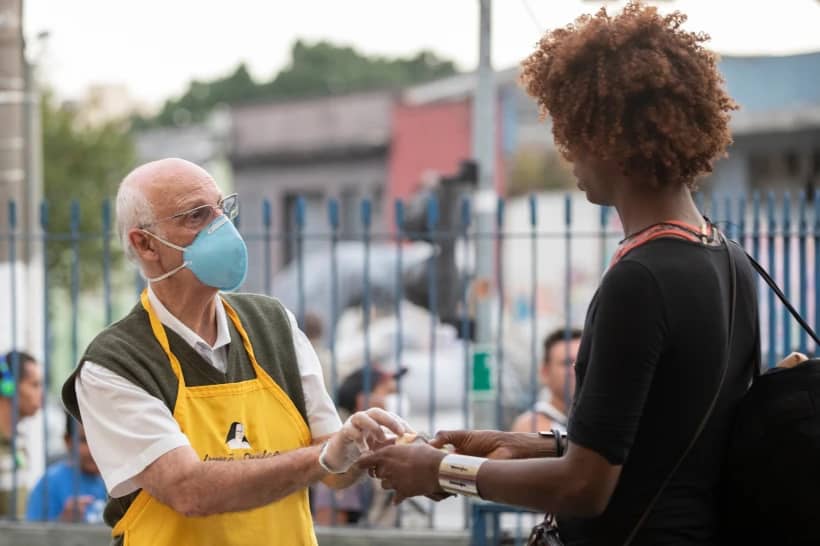MIAMI — In a sign of hope, all grade levels at Mary, Star of the Sea Catholic Academy in Freeport, Grand Bahama, started holding classes Sept. 23 — at least on a part-time basis.
“The structure did have flooding and the junior school was not open until now, at least for a few hours each day,” said Arnold Neely, a longtime resident, who rode out Hurricane Dorian, a Category 5 storm, at Mary, Star of the Sea, which is his parish.
“Schools are now opening, even if not full time, and children are trying to get back to normal. This has been a traumatic experience even for adults,” Neely said.
Speaking by telephone Sept. 22 with the Florida Catholic, Miami’s archdiocesan newspaper, Neely said that waters have receded in the Freeport region, allowing many aspects of daily life to return to the area.
He noted that Mary, Star of the Sea — the mother parish of five other parishes in Grand Bahama — now serves as a distribution point for donated supplies while at least 200 people live in various shelters on the island.
With emergency supplies now readily available on Grand Bahama, residents are not looking toward reconstruction, which will require additional labor and building materials, said Neely.
Following the impact from the most powerful hurricane in the history of the island, many displaced residents are believed to have temporarily moved in with family or friends in Nassau or the United States.
Grand Bahama suffered about eight of the 53 documented fatalities associated with Hurricane Dorian, while most of the other reported fatalities were associated with the hard-hit Abaco Islands area, according to Neely.
In the east end of Grand Bahama, the government-affiliated University of the Bahamas, which had reported a significant boost in enrollment this year, suffered devastating damage to its northern campus, leaving the newest building, a residence hall, completely gutted. Students there are expected to transfer to the main campus in Nassau or to other universities.
As many as 75,000 residents were impacted and 1,300 are still officially listed as missing after the powerful storm stalled over the northern Bahamas Sept. 1-3.
The state of Florida reports that more than 4,000 Bahamians have temporarily evacuated there, though how long they will be allowed to stay remains unclear.
“The destruction is massive in the east end, but not in the city I live in, which was all flood damage 6 feet high in some cases — meaning all furnishings and appliances have to be discarded,” Neely said of Grand Bahama. “Structural damages there are minimal, and no (devastating) damage to any of our churches on the island.”
Emergency aid, he said, has been flown and shipped in relatively quickly and distributed by churches, charitable agencies and the government. He added that the seaport at Freeport is functioning and the international airport is open to emergency traffic.
“Food and water is available. And now things are moving into the restoration part of the recovery where homes have to be renovated or restored to be made livable again. But on the island, as far as I know, we have only one hardware store open for business,” said Neely.
The Wall Street Journal reported that initial estimates put the cost of removing debris in Abaco and Grand Bahama alone at about $74 million.
Another sign of recovery in Grand Bahama was the quick resumption of liturgical services at Mary, Star of the Sea, where the daily Mass schedule was only interrupted for several critical days during the hurricane’s impact.
At the church, the clergy and staff had a generator, but lacked water pressure, electricity and internet. The local radio station and telephone service were also not functioning in the storm’s aftermath. Neely said his own home suffered mostly rain-related water damage, while many of his neighbors’ homes were completely flooded.
“We are on the road to recovery. There was a time you could not call me on my cellphone, but that is coming up again and internet is available but may be fragmented in some places,” said Neely, who has lived in Grand Bahama for 50 years and described Dorian as the more ferocious hurricane he’s experienced anywhere.
He said he hopes Dorian hasn’t written the final chapter for the youths and residents who have temporarily fled Grand Bahama or who are feeling overwhelmed at the scale of recovery ahead.
“I am very optimistic, and I have children and grandchildren — I would like for them to continue with the Bahamas as their home and I would like to see it come back,” he said. “Somebody has to be here to carry on the lineage and tell the stories. And a lot of those residents who left will return for employment in reconstruction.”
Neely said the people of the Bahamas fully appreciate all the support they have received from abroad. “And we are very proud to be affiliated with the United States, our sister country, and all the help from all the organizations who are looking out for us.”
Tracy writes for the Florida Catholic, newspaper of the Archdiocese of Miami.
Crux is dedicated to smart, wired and independent reporting on the Vatican and worldwide Catholic Church. That kind of reporting doesn’t come cheap, and we need your support. You can help Crux by giving a small amount monthly, or with a onetime gift. Please remember, Crux is a for-profit organization, so contributions are not tax-deductible.













